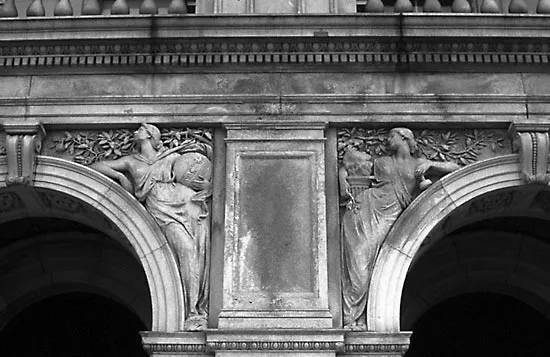Spandrels

“Spandrel” is a term from architecture, meaning the triangular areas above and on either side of an arch.1 1 Inevitably, it seems as though strictly speaking, the spandrels of San Marco that Gould and Lewontin reference in their paper are not true spandrels. This happens more often than you might think. Stonehenge is, similarly, not a henge. This is apparently an example of Eleanor Rosch’s prototype theory, which says that we organize categories around examples, not definitions. As in the photo above, these have become a site of ornamentation. Evolutionary biology borrowed this concept, to name features that arise as byproducts of other decisions. Medieval architects didn’t start designing spandrels as a site for additional carvings of ladies. They designed stone arches, which produced extra triangles of space, which then became a new site for innovation. “Spandrel,” in the more general sense, then, has become a term for the inevitable byproducts of architecture, I would argue, whether performed in the physical world or digitally.
Who among us has not looked at a pre-existing structure and thought “huh, I bet I could stick something there. It would work”? It’s the main way of doing digital architecture (whether technical or information) when you’re not thinking about it hard or it’s nobody’s job. I would argue that the use (and over-use) of spandrels is the main way that Big Balls of Mud get created, because spandrels easily bring with them architectural debt. It’s not that they’re bad, but a feature arising from a spandrel easily becomes table-stakes, which means that the underlying structures can’t be removed without losing the essential feature.
This happens much more frequently than we like to think, because adaptationism is such an endemic bias in Western thought. Adaptationism tells us that features exist the way they do because they’re well-suited for the job they’re asked to do. Realistically, they’re often just load-bearing accidents.
References
Foote, B., & Yoder, J. (1999). Big Ball of Mud. Pattern Languages of Program Design 4. http://www.laputan.org/mud/?ref=coding-horror
Gould, S. J. (1997). The exaptive excellence of spandrels as a term and prototype. Proceedings of the National Academy of Sciences, 94(20), 10750–10755. https://doi.org/10.1073/pnas.94.20.10750
Gould, S. J., Lewontin, R. C., Maynard Smith, J., & Holliday, R. (1997). The spandrels of San Marco and the Panglossian paradigm: A critique of the adaptationist programme. Proceedings of the Royal Society of London. Series B. Biological Sciences, 205(1161), 581–598. https://doi.org/10.1098/rspb.1979.0086
Notes mentioning this note
Geographic knowledge is essential to us. We use it to know where things are and to use that knowledge as...
Technical architecture has a mature understanding of architectural patterns. That’s not something we think explicitly about much in IA, but...
The quality of systems thinking and decision making in an organization of people determines the quality of their architecture, for...